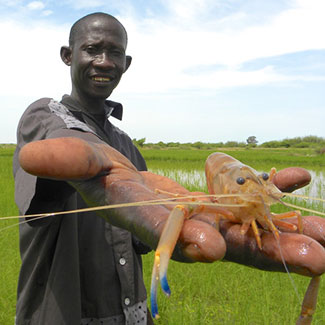Prawn farming reduces disease transmission, provides food source

Photo courtesy of Upstream Alliance
By introducing prawns into the Senegal River basin, researchers
dramatically reduced the population of snails carrying
parasites that were responsible for a rise in schistosomiasis
after a dam was built.
With one billion of the world’s people suffering from malnutrition, there is pressure to intensify agricultural production, especially in the world’s poorest countries. However, there is tension between the need to supply more food and the ecological impact that can have. Deploying herbicides, fertilizers, pesticides - as well as improving irrigation - can have unintended consequences for the spread of infectious diseases.
For example, a small dam was built in the Senegal River basin in 1986 to block salt water flowing upstream from the ocean so crop cultivation could be expanded. Shortly after, the local population experienced recurring outbreaks of schistosomiasis, a debilitating disease. Scientists hypothesized that enlarging the area of freshwater in the river basin may have created the ideal habitat for the snails that host the disease-causing parasites, while reducing upriver migration of fish and other snail predators. In addition, agrochemical runoff may have increased algae growth providing a food source for snails, while insecticides might have reduced populations that would normally consume snails, such as prawns, crayfish and water bugs.
A research team led by Dr. Jason Rohr at the University of Notre Dame has been using a Fogarty ecology and evolution of infectious diseases grant to investigate various aspects of the complex problem. Collaborator Dr. Susanne Sokolow has been conducting research in the region since her postdoc, which was funded in 2009 by the NIH’s National Institute of Allergy and Infectious Diseases. “Every year the government distributed praziquantel, the recommended anti-parasitic drug for schistosomiasis, to all the kids,” said Sokolow. “And yet each year they came back re-infected at almost the same rates as the previous year.” Among rural children, prevalence topped 80%. The scientists wanted to understand pre- and post-dam river ecology in order to “creatively interrupt part of the parasite’s lifecycle,” said Sokolow, who leads Stanford University's disease ecology program.
Working in partnership with a local Senegalese biomedical research institute, one experiment looked at the effects of herbicides on the life stages of schistosomes. Another stocked the Senegal river with native prawns as determined by mathematical models drawn from Sokolow’s previous research. This included the observation that prawns consume snails at daily rates of up to 30% of their body weight. The intervention worked: the number of infected snails was reduced by 80% and the local population finally escaped yearly schistosomiasis reinfection. In addition to improved health, the community also gained a dietary protein source and a new cash crop.
Care must be taken when considering introducing predators into the environment, Sokolow noted. Previous attempts with American crayfish successfully reduced schistosome-hosting snails in African bodies of water but they also eroded river banks, devoured crops and caused declines in native species.
Her team’s most recent experiments, funded by the same Fogarty grant plus other benefactors, focus on agrichemicals and explore how run-off pesticides might kill susceptible prawns. One of Sokolow’s experiments uses drones to map river plant life to predict human reinfection rates. “Environmental diagnostics” could someday complement medical treatment and accelerate wellness, Sokolow said.
She believes lessons learned in the Senegal river basin have the potential to reduce global suffering of schistosomiasis, which affects more than 240 million people worldwide and can lead to anemia, impaired growth and development, liver damage and bladder cancer. She led an analysis of schistosomiasis infection data from sub-Saharan Africa before and after construction of 14 large dams and concluded the prawn intervention should be more broadly adopted. “If this could be extended to the agricultural landscapes of Africa and the Americas where schistosomiasis transmission is highest, prawn aquaculture might offer a powerful tool in the global fight against schistosomiasis.” She also posed a question for future research: “For what other human disease systems can win-win solutions for people and nature be carried out successfully at scale, while remaining cost-effective?”
Adapted from the November / December 2020
Global Health Matters article Prawn farming reduces disease transmission, provides food source in Senegal.
More Information
Related Fogarty Programs
Related Global Health Research Topics